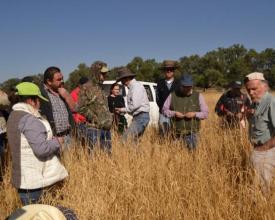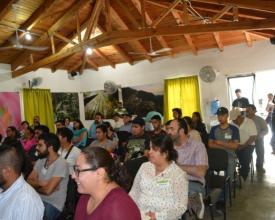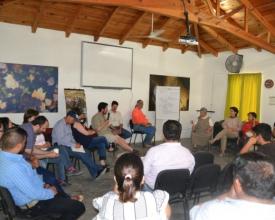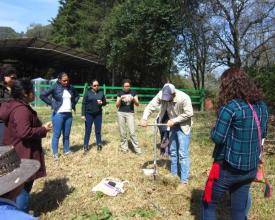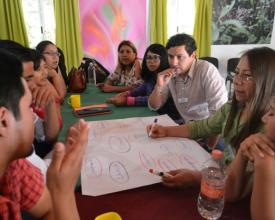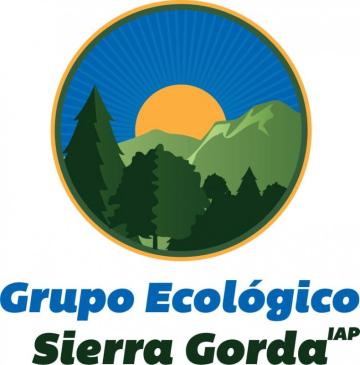
Transformation de la société rurale, régénération et valorisation des services fournis par la nature.
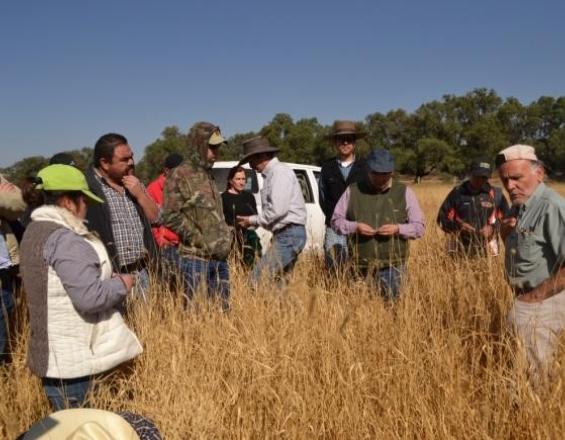
Le mécanisme national de compensation du carbone de l'État de Querétaro intègre un financement infranational par le biais de petites taxes sur le carbone, un protocole local et contextualisé adapté aux propriétaires terriens et l'utilisation d'outils de régénération dans la gestion des sols et des forêts. Le résultat est le rétablissement de la santé des forêts et de la couverture végétale.
Il y a trois ans, nous avons commencé à transférer cette initiative à d'autres gouvernements infranationaux en organisant des ateliers, en formant des techniciens et des producteurs à la gestion régénérative, en définissant des zones d'opération et en analysant des options de financement innovantes.
Ainsi, nous déclenchons des changements transformationnels dans les secteurs agricole et forestier et nous contribuons à rétablir la santé des forêts et la couverture végétale. Cela permet de protéger la biodiversité, d'augmenter les services écosystémiques et de favoriser la régénération naturelle.
Cette politique publique fait l'objet d'un développement des cinq lignes directrices en tant qu'adopteurs précoces de l'Initiative pour la transparence climatique (ICAT).
Contexte
Défis à relever
Environnement: Au Mexique, les pratiques qui entraînent la dégradation des forêts et des sols, telles que le pâturage bovin non géré, réduisent considérablement les stocks de carbone et la biodiversité. Pourtant, ces pratiques agricoles traditionnelles sont perpétuées et les incitations à la transition vers un pâturage planifié et régénérateur sont inexistantes. De nombreux États mexicains élaborent des plans et des stratégies d'atténuation et d'adaptation au changement climatique. Ces plans n'incluent pas la gestion des pâturages en raison d'un manque de sensibilisation à leurs avantages potentiels en termes de carbone.
L'économie: Des investissements supplémentaires sont nécessaires pour les infrastructures de gestion de l'eau, les équipements tels que les clôtures électriques et la main-d'œuvre.
Social: la biodiversité et le capital naturel n'ayant pas de valeur économique pour les propriétaires terriens, ils risquent fort d'être dégradés par le pâturage incontrôlé, l'abattage clandestin, les incendies de forêt, etc. En outre, des politiques publiques obsolètes subventionnent le pâturage non rentable et nuisible du bétail dans les forêts.
Emplacement
Traiter
Résumé du processus
Tout d'abord, nous présentons et promouvons notre stratégie auprès des gouvernements des États du Mexique. Ensuite, nous organisons des ateliers techniques au cours desquels nous formons les fonctionnaires de l'État, en adaptant la stratégie au contexte et aux priorités propres à chaque État. Nous nous efforçons également d'aligner les politiques publiques et d'analyser les possibilités législatives de mise en œuvre.
Nous formons des éducateurs à la gestion régénératrice avec le cours Holistic Management Diploma en partenariat avec l'Institut Savory, et nous organisons des forums nationaux, des ateliers et des réunions au cours desquels les participants partagent leurs expériences. Nous nous concentrons sur le renforcement des acteurs clés tels que les organisations de la société civile. Nous mettons en place des systèmes de surveillance du carbone dans les forêts et les sols sous gestion et formons les participants à l'adoption des lignes directrices de l'ICAT afin de garantir l'approbation de l'initiative et d'atteindre des objectifs plus ambitieux dans le cadre des CDN.
La Banque interaméricaine de développement cherche également à reproduire ce projet NAMA, qui est un exemple de réussite d'un projet développé par le FIM à l'aide de fonds mondiaux. Enfin, nous collaborons avec la prochaine administration de SEMARNAT pour mettre en œuvre cette initiative au niveau fédéral.
Blocs de construction
Le mécanisme de compensation carbone de l'État, contextualisé dans le cadre d'un protocole local.
Le protocole local contextualise le protocole de Kyoto en l'adaptant aux conditions locales, développe des méthodologies MRV (mesure, rapport et vérification) formelles et contextualisées, et confère une valeur au capital naturel d'une manière qui favorise les propriétaires terriens.
Nous proposons de reproduire cet élément de base au niveau infranational : le financement de l'atténuation de l'empreinte carbone par le biais de petites taxes d'État qui constituent un fonds d'État - fonctionnant selon un protocole local, adapté aux contextes des propriétaires fonciers - avec un financement supplémentaire par des organisations gouvernementales - la CONAFOR et la SAGARPA. Nous fournissons une assistance technique aux fonctionnaires d'autres États pour qu'ils adaptent ce modèle à leur contexte et à leurs priorités.
Dans un souci de transparence et de normalisation, nous utilisons les méthodologies validées de l'ICAT pour calculer les réductions de carbone basées sur la récupération du capital naturel. Nous développons des modèles écologiques personnalisés pour différents États et fournissons une formation pour aligner les politiques publiques, en promouvant un financement innovant par le biais de petites taxes sur le carbone au niveau de l'État et d'un investissement fédéral accru orienté vers l'intégration de pratiques régénératives. Il s'agit d'une politique publique qui incite à l'atténuation du climat et à la régénération des infrastructures naturelles, ancrée dans une réponse collective de la société rurale.
Facteurs favorables
L'urgence d'intégrer des pratiques qui régénèrent le capital naturel est renforcée par les résultats très positifs des ranchs pilotes. D'autres États s'y intéressent vivement.
Notre initiative, incarnée par la NAMA NS-272 "Subnational mitigation actions for the restoration of degraded forests and the implementation of planned grazing", propose une action bien planifiée et comprend des outils qui permettent de la reproduire dans d'autres contextes.
Leçon apprise
Un large éventail d'outils a été défini, développé et appliqué dans le cadre de la mise en œuvre de cet élément constitutif. Ces outils comprennent l'adaptation des modèles en vue de leur reproduction dans des États ayant des besoins et des contextes différents, des systèmes de suivi, des rapports et la vérification de la conformité et des résultats dans les sols et les forêts, des accords entre les parties, l'analyse des opportunités fiscales, des règles de fonctionnement et des lignes directrices visant à garantir la transparence dans la gestion des fonds pour l'environnement. Un outil important consiste à personnaliser les modèles pour reproduire cet élément de base dans différents États.
La Banque interaméricaine de développement souhaite poursuivre son soutien en recherchant des ressources financières provenant de fonds climatiques à plus grande échelle.
Le bureau SEMARNAT (Secrétariat de l'environnement et des ressources naturelles) de l'administration du président élu du Mexique a manifesté son intérêt pour l'adoption de ce programme en tant que ligne d'action stratégique pour les six prochaines années. Ce soutien est d'une grande valeur et ouvre de nouvelles possibilités de diffusion et d'application.
Transfert de connaissances dans la gestion régénérative des sols.
Ce volet consiste à transmettre les connaissances en matière de gestion régénérative des sols aux techniciens, aux producteurs et aux fonctionnaires de l'État.
Nous proposons une formation diplômante en gestion holistique au Centre de la Terre, notre établissement d'enseignement qui propose en moyenne 40 ateliers par an et tire parti des 30 années d'expérience de GESGIAP dans le domaine de la conservation et du développement durable. La formation diplômante en gestion holistique est suivie par des fonctionnaires, des techniciens, des producteurs et des étudiants et couvre des sujets tels que les conceptions hydrologiques en ligne clé, la lutte contre les parasites, les cultures bio-intensives et la préparation des bio-fertilisants. Elle a un impact réel sur la formulation des politiques publiques dans l'État de Querétaro, l'application des ressources, la gestion des troupeaux de bétail et, par conséquent, la régénération des sols.
Les ateliers, les événements de mise en réseau où les participants partagent leurs expériences, la formation technique continue et le soutien aux producteurs qui adoptent des outils de gestion régénératrice sont également des éléments fondamentaux de cet ensemble.
Facteurs favorables
Nous veillons à ce que les conditions nécessaires soient réunies en créant des alliances entre les producteurs, les techniciens et les fonctionnaires, en guidant et en orientant les politiques publiques, en fournissant une formation et un soutien techniques aux producteurs, en gérant les ressources pour un développement optimal des infrastructures et en encourageant le sens des responsabilités et de la gestion de l'environnement chez les participants. De cette manière, nous créons une culture de la conservation et de la citoyenneté écologique participative qui est réceptive à la mise en œuvre d'une gestion régénératrice des sols.
Leçon apprise
Nous avons appris que pour obtenir un impact permanent, nous devons accompagner les projets jusqu'à ce que nous soyons sûrs que les participants ont développé toutes les capacités nécessaires. Nous devons également aider les participants à développer des infrastructures et à acquérir du matériel ; organiser en permanence des ateliers pour créer des alliances entre les participants ; optimiser la gestion des ressources ; assurer un équilibre entre la conservation des ressources et la création d'opportunités économiques ; et mettre en place des systèmes de suivi et d'évaluation qui systématisent les expériences et enregistrent l'impact des actions et des stratégies.
La conservation de la biodiversité, souvent considérée comme un fardeau économique pour les communautés rurales, n'est pas garantie par le seul fait de décréter qu'un territoire est une zone protégée. Pourtant, grâce au travail de GESGIAP depuis plus de 30 ans - éducation, formation, accompagnement technique - on assiste à l'émergence d'une société dotée de capacités de durabilité et d'un sentiment d'appartenance, qui défend le territoire et travaille à la restauration de la biodiversité.
Impacts
Le pâturage planifié, une mesure conditionnelle des CDN du Mexique, a un potentiel d'atténuation annuel de 5,6 MtCO2e d'ici 2030 selon l'Institut national de l'écologie et du changement climatique (INECC).
Ce projet de soutien à la NAMA (NSP) est l'occasion de mettre en œuvre le pâturage planifié - une mesure d'atténuation conditionnelle identifiée au niveau national - qui devrait régénérer environ 788 000 ha et permettre une atténuation cumulée de 7,2 MtCO2e sur 5 ans. Le PSN contribuera également à la réalisation des objectifs d'adaptation au changement climatique de la CDN du Mexique en matière de gestion de l'eau et de diversification de l'agriculture durable.
La composante restauration des forêts du PSN devrait, selon les projections préliminaires, restaurer 338 000 ha et permettre une atténuation cumulée de 2,47 MtCO2e sur 5 ans. Il contribue aux objectifs d'adaptation de la CDN du Mexique en matière de conservation et de restauration des écosystèmes afin d'accroître la connectivité écologique des zones naturelles protégées.
En valorisant quantitativement et financièrement les ressources naturelles, le PSN fournit des capitaux aux communautés rurales qui possèdent des sanctuaires de biodiversité mais vivent dans une extrême pauvreté. Il apporte ainsi des avantages à la population tout en régénérant et en conservant les forêts et les espèces sauvages.
Nous transformons une société sans direction qui gaspille ses ressources naturelles en une société qui fournit des services écosystémiques, régénère les sols et les forêts et augmente le captage du carbone et de l'eau dans les forêts.
Bénéficiaires
Les bénéficiaires sont les communautés propriétaires des terres de la réserve de biosphère de Sierra Gorda, les producteurs agricoles, les propriétaires forestiers, les voyagistes communautaires, les autorités locales, les enseignants, les parents, les groupes de femmes, les jeunes et les enfants.
Objectifs de développement durable
Histoire
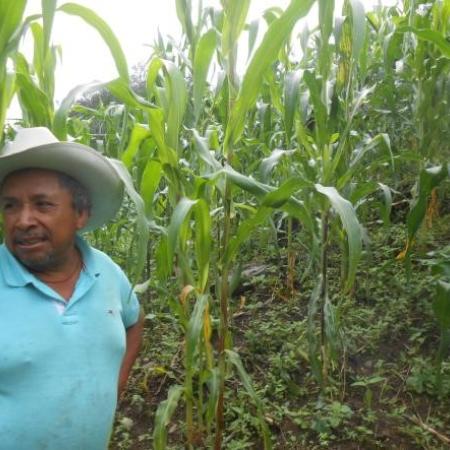
Trente années se sont écoulées en un clin d'œil, mais le cœur du Grupo Ecológico Sierra Gorda IAP (GESGIAP) reste attaché à la Sierra Gorda. Ce patrimoine sacré du Mexique est une tapisserie de biodiversité ; son héritage éternel est stupéfiant et nous nous sentons obligés de protéger sa vitalité.
Le changement climatique et la voracité humaine ont amené cette biosphère fragile au point d'épuisement. Nous avons honte de mettre en péril la survie des espèces qui coexistent avec nous sur cette planète. Qui nous a donné la permission d'abuser et de vendre des infrastructures naturelles irrécupérables ?
L'humanité doit agir maintenant. Nous devons devenir des citoyens écologiques, mettre en œuvre des solutions locales et inciter nos communautés à changer afin de relâcher la pression que nous avons exercée sur la Terre, cette œuvre d'art divine. Avec dévouement et passion, GESGIAP construit un mouvement d'amour pour la planète, un mouvement qui se traduit par des actions à tous les niveaux, de l'international au personnel.
GESGIAP a mis en œuvre d'innombrables projets communautaires et de conservation, y compris l'éducation à l'environnement et la reforestation.
l'éducation à l'environnement et la reforestation. Au fil du temps, ces projets ont acquis une reconnaissance nationale et internationale. Aujourd'hui, GESGIAP se concentre sur les politiques publiques et la diversification des revenus dans la région par le biais de l'écotourisme, d'ateliers d'artisans et de formations. Il développe des moyens de monétiser les services environnementaux et les infrastructures naturelles afin de fournir une compensation économique aux propriétaires terriens qui pratiquent la conservation. GESGIAP consolide ainsi une économie de la conservation qui harmonise la conservation de la biodiversité avec le développement économique local.
Nous partageons les meilleures pratiques avec les propriétaires forestiers, les agriculteurs et les gouvernements nationaux par le biais de la formation et de l'assistance technique. Nous aidons les personnes vivant dans l'extrême pauvreté à accéder à des ressources financières en monétisant les services environnementaux. Nous nous efforçons de rétablir la productivité des sols et de créer des puits de dioxyde de carbone et d'eau dans toute la Sierra Gorda. Grâce à notre travail, des agriculteurs expérimentés de tout le Mexique pratiquent désormais le pâturage planifié.
Nous gérons également un réseau de réserves naturelles privées qui servent de refuge à des espèces menacées telles que les jaguars. En réduisant la pression humaine sur les habitats de la faune sauvage, nous sommes en mesure de protéger l'essence sauvage des montagnes de la Sierra Gorda.
Nous opérons dans sept États du Mexique, en nouant des relations et en saisissant toutes les opportunités. Cette réponse collective nous permet de renforcer la résilience des communautés et de faire face ensemble à l'urgence climatique à venir.
